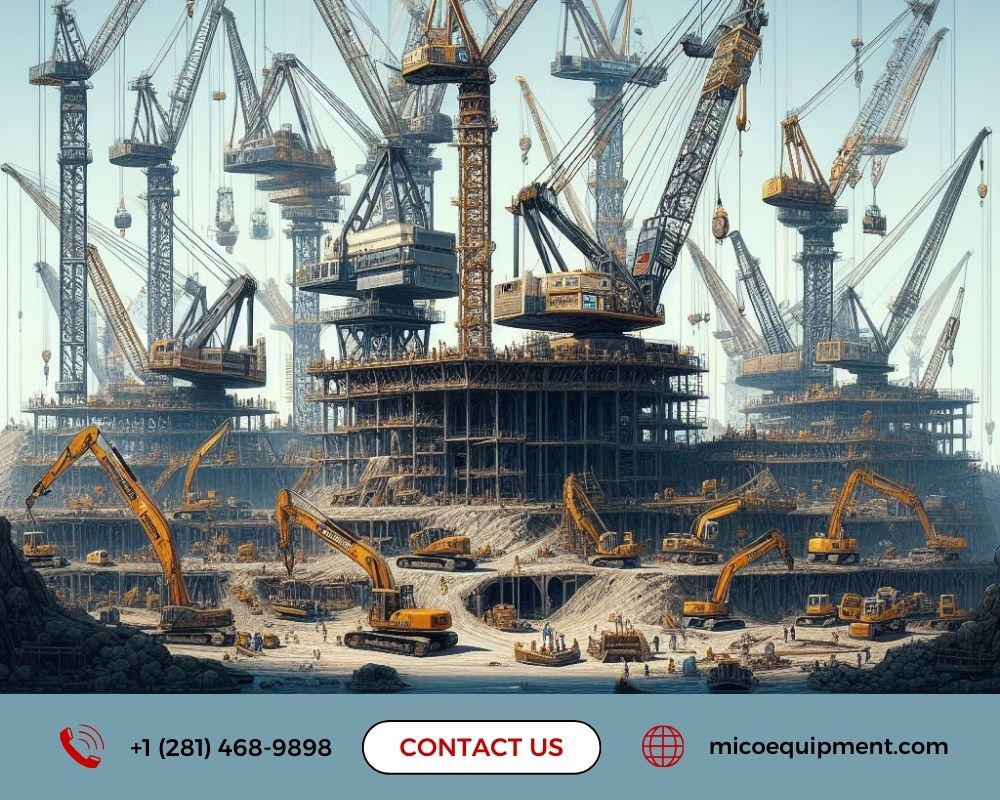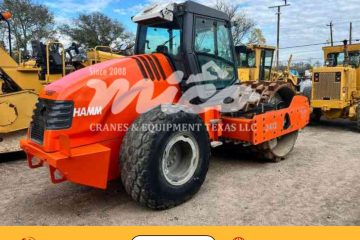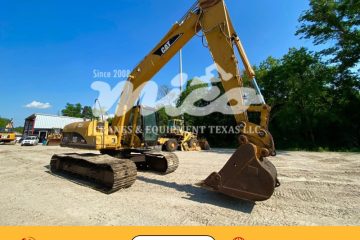Ultimate Guide on Cranes: The Giants of Construction

Sky-touching infrastructures are the marvels of the construction sector, which are not just developed with steel and concrete but also require the technical support of mighty cranes. These titanic machines act as silent giants to provide back support and a powerhouse of construction landscapes. They are involved in lifting and moving massive objects high about the ground with these engineer designs of used cranes all over the world.
In this exploration, we try to understand the fascinating world of cranes with brief details on their evolution. Also, it outlines various types of in-use cranes and their proficiencies to reshape the dynamics of the construction industry. So, buckle up Mico Equipment to embark on a successful business journey with used heavy equipment for sale.
Historical Overview of Cranes
Cranes have traces from ancient Greece history around 500 B.C. In the beginning, people used tongs and Lewis irons to lift heavy objects. Afterward, they shifted towards manual-powered pulley systems and treadwheels, which were transformed into steam-generated power in later years.
With technological revolutions, hydraulic arms, and electric motors took over control. Here comes the evolution of cranes to provide unbeatable lifting capabilities in the modern construction industry.
Technical Parts of the Construction Crane
To understand the applicability of cranes in the dynamic sector, there is a need to concise the details about technical components. However, the introductory chemistry is the same for diverse types and makes of this giant second-hand machinery.
Improve Reach with Boom
Well, the boom of the crane is the elongated arm that can be fixed or telescopic. It acts as the primary tool involved in the lifting and reaching mechanism, regardless of any brand or model assembly. However, these are the significant parts capable of moving and bearing heavy materials to proposed locations or construction sites.
Versatile Jib
To transport the load safely to the desired distance, the boom of the crane has an attached jib and a lattice-shaped structure at the bottom. Additionally, the size and dimensions of jibs are fixed, unlike the boom, which can be extended or retracted according to requirements. Notably, the prime focus of this design is to keep away the weight from the crane structure to minimize any collapse damage.
Rotational Rotex Gear
Indeed, to facilitate the smooth movements of the cab and boom, the Rotex gear is installed. Although they perform a simple function of rotating the boom left to right direction, it is an incredibly vital function. This mechanism is essential to transport the construction crane to the desired site.
Counterweights for Stability
The name counterweight clearly describes its usage and purpose. They are definitely strategically positioned to create an equilibrium between the lifted weight and the crane’s body. Therefore, it supports smooth task execution without tipping over heavy machinery.
In some tower cranes, there is an option for counterweight adjustment to maintain safe operations for specific requirements of the job. Commonly, the counterweights are seen in the opposite direction of the jib.
Outriggers for Crane Safety
For safety measures, outriggers are installed to make handling heavy construction equipment more secure and user-friendly. It provides additional support and steadiness by allocating the crane’s load over a broader area to mimic tipping.
However, the provisions of the outrigger are not applied to uneven surfaces; OSHA recommends grounding the cranes on smooth and solid grounds to reduce the chances of accidents and instability.
Reinforced-Steel Lifting Cable
Cranes to lift and move material require a powerful line or rope, known as reinforced steel cables. In fact, in the 1830s, mining experts used steel wires at hoist vents. Here, the idea is manipulated in crane structures that are highly resistant to corrosion, uphold mechanical stress, and have a solid potential to face wear and tear.
Linking Hook
Finally, to support the attachment of the crane with the material to be transported, the crane has rubout hooks. As the name suggests, these are curved iron or steel bodies with safety latches to hold them safely and prevent them from slipping off the material from the hook.
These focal components of used cranes for sale are quality-assured to deliver accurate functions with adequate safety measures. Impactfully, these parts are fundamental; the updated versions may have incorporated more specifications and additional features to improve versatility and performance.
Explore Different Types and Applications of Cranes
Today, the construction sector utilizes a diverse array of cranes to facilitate specific functions, and each design has unique technical specifications. However, a great choice can create a panic situation when selecting the most suitable among diverse varieties and makes of construction cranes.
Well, to provide ample knowledge to users, we have compiled a directory of frequently available cranes in Texas, US. Obviously, the primary category is mobile and fixed cranes. They both have distinct functions and unique performances.
1. Carry Deck Crane
To manage heavy workloads with limited space, carry deck cranes come in a compact mobile structure integrated with a small deck for secure material handling. Obviously, such heavy construction equipment is characterized by the versatility of operations with durable material.
Key Features
- Carry deck cranes are flexible to execute various tasks of lifting, transporting, and positioning loads in restricted spaces with safety measures.
- Indeed, with its compact size and handy design, it can quickly move around heavy obstacles and operate effectively.
- The upper structure has a 360-degree rotation ability for precise placement of objects without moving the crane for its position.
Application
Carry deck cranes are commonly installed at heavy-duty industrial operations, transportation services in warehouses, and construction sites, with less working area. Also, it is utilized in maintenance operations of commercial or residential settings.
2. Crawler Crane
Crawler cranes are powerfully designed and mounted mobile cranes on tracks rather than wheels. Furthermore, it provides secure and stable movement only on smooth and uneven terrain. It is also motorized with a lattice boom for high lifting proficiency with long reaches.
Key Features
- Built-in track mobility enables crawler cranes to traverse rough but soft terrain. Impactfully, capable, and suitable for working at off-road construction sites.
- A wider foot area of tracks evenly distributes the crane’s weight, supporting the slip-free and stable allocation of the device.
- Moreover, the adjustable dimensions of the telescopic boom ensure the variable boom lengths reach more significant elevations and distances.
Applications
Crawler cranes are suitable options for industries where the materials have to be transported to high heights and longer distances by moving the crane from one site to another. Well, the common contributors are heavy construction projects, massive infrastructure development, and industrial operations with heavy load mobility.
3. Floating Crane
Simply put, crane vessels or crane ships are mobile cranes effectively engineered to work in marine environments and water tanks. They are structured explicitly with corrosion-free material to operate in water and are equipped for offshore lifting operations.
Key Features
- Floating cranes can work on water, offshore sites, and in port to transport the heavy materials in and around the ships.
- These cranes are integrated with mighty arms capable of handling massive objects like import/export containers and offshore shipping of used heavy construction equipment for sale.
- The versatility of floating cranes in aquatic environments allows cargo handling service and shipbuilding.
Applications
Floating cranes have a vivid market value in maritime industries, especially in oil and gas exploration and cargo industry, and facilitate marine construction operations. Impactfully, the loading and unloading tasks at ports are the main economic drifts in Texas international markets.
4. Rough Terrain Crane
specially designed powerful cranes for challenging terrains of off-road operations like far-distance mining sites and tricky construction sites and to facilitate remote locations. Rugged materials and high mobility with four-wheel and telescopic booms characterize them.
Key Features
- Potentially equipped with four-wheel traction tires with environmentally resistant structures to reach out rough terrain, these cranes can approach muddy and uneven grounds.
- The extendable telescopic booms customized according to the project requirements are available in stock as used cranes for sale under warranty covers.
- Despite rugged material construction, rough terrain cranes are compact structures that deliver optimal performance in the most minor space operations.
Applications
Rough terrain cranes are an alternate substitute for most struggling tasks where ordinary cranes are failed. Conversely, to get maximum yield at intricate construction sites, infrastructure development, and mining procedures are demanded. They excel in providing more comprehensive coverage of heavy materials lifting and transportation.
5. Truck-Mounted Crane
These mobile cranes are mounted with adequate truck chassis to facilitate accessible transport services on highways and roadways. They are definitely, performing a flexible range of tasks, including shifting the massive loads to a great height and distance. Also, they have built-in counterweights and outriggers to maintain stable moves.
Key Features
- Truck-mounted cranes can be driven effortlessly on public roads to reach a particular site. Therefore, it reduces the transportation costs to install at the construction site.
- Definitely, the integration of counterweights and outriggers minimizes the chance of equipment typing and slipping, ensuring safe and efficient handling in sloppy areas.
- The hydraulic system feature is deployed by extending the boom to develop rapid task execution with precision.
Applications
The potential field users are mainly construction companies, infrastructure maintenance providers, and tasks that require quick response. Project managers’ loading and unloading provisions are streamlined with these innovatively designed cranes.
6. Stacker Crane
automated controlled stacker cranes are primarily integrated with warehouse machinery for safe storage operations. Additionally, these high-demanding cranes efficiently retrieve and store material in limited space store. Notably, the goods are piled up to overcome high-density storage systems.
Key Features
- The incorporation of computer systems monitoring or programmable logic controllers (PLCs) with these cranes improves precision and error-free executions.
- A forklift-like lifting mechanism for picking and placing pallets or containers improves accuracy. Likewise, the adjustments of telescoping booms or shuttle systems increased performance.
- Excel supports operations to maximize the warehouse’s storage capacity and organize the material neatly.
Applications
Frequent utilizers are distribution centers, logistics service providers, and warehouses of manufacturing units with automation-monitored storage. By buying these second-hand cranes, the business can reduce labor costs and improve inventory control.
7. Telescopic Crane
Telescopic cranes have high-precision hydraulic cylinders for managing the lifting process, and they are adjustable and smooth to customize the boom length. Mico equipment allows a versatile product range of used cranes for sale with simple configuration and adaptability provisions.
Key Features
- Hydraulic cylinder installation enhances the telescopic crane’s capability to transport and lift heavy loads over an extensive range.
- The multitask execution quality makes this heavy machine a versatile option formaterial handling, device installation, and maintenance work.
- Suchcranes have mounted mobile trucks that are easily transported between job sites.
Applications
The quick movements to project sites make it equipment used in emergencies, high-demand construction sites, and utility maintenance services. The personalized shafts and booms support rapid excavation to assist accident recovery moves during natural disasters.
8. Tower Crane
Tower cranes, as the name depicts, are employed in the development phase of tall buildings and commercial sectors. Therefore, it is renowned for extensive reach in terms of height and weight range for lifted material.
Key Features
- Indeed, the height of the tower cranes is a prime feature to meet the demands to reach the material for multistory buildings in the construction phase. The vertical tower supports the movement of arms to greater distances with safety.
- Also, the capability to uphold heavy loads like carrying steel beams, gardeners, prefabricated components, and concrete panels.
- Theconcrete foundation or ground-anchored base system provides security and stability of movements and work efficiency.
Applications
These are indispensable assets required to manage high-rise building projects, skyscraper infrastructures, and apartment construction. Definitely, the market demand for used cranes for sale in Texas needs a reliable partner like Mico Equipment to streamline complex operations.
9. Bridge/Overhead Crane
Bridge or overhead cranes are heavy-duty and ergonomically designed industrial-scale lifting machines. Previously, it required managing the storekeeping of warehouses, spare parts manufacturing plants, and intricate industrial settings. They are characterized by a bridge-like structure spanning the workspace, with a hoist mechanism traveling along the bridge to lift and move loads.
Key Features
- Reliableconfiguration setups enable such cranes to handle and transport heavy weights without creating mass in high-demand industries.
- The hoist supportive mechanism empowers along the vertex of the bridge, enabling secure and high-efficiency movements in vertical and horizontal directions.
- Industrial workspaces took the practical benefit of bridge cranes with minimum floor space use and reduced the need for further adjustment for mounting it properly.
Applications
The everyday users of bridges or overhead cranes are logistics operations firms, material handling companies, and industrial manufacturing processes. They are involved in the safe and demanding loading/unloading of raw materials and end products within the facility.
10. Bulk-Handling Crane
Bulk-handling cranes, as the name suggests, are involved in transporting large volumes of loads and are designed to cope with extensive usage capacity. The mining industry is used to extract coal or minerals; likewise, cargo companies require these high-performance devices.
Key Features
- When long hours of working are required without any chance of accident and equipment failure, bulk-handling cranes are ideal solutions.
- Secure grabbing mechanism or clamshell bucket integrations efficient and error-free loading and unloading of bulk materials.
- Bulk-handling cranes are multipurpose machines proficient in handling different types of bulk materials at commercial scales with ease to provide workplace security.
Applications
When there is extensive shifting of cargo and containers at the port, material moves in the mining industry, and material is transported in trains, ships, and trucks for locomotion.
11. Hammerhead Crane
Hammerhead cranes, or top-slewing cranes, are heavy-duty equipment with precision to deliver reliable outcomes in a short time. Notably, a horizontal lever or jib arm is installed on a static tower, enabling smooth movements quickly.
Key Features
- The Racking Mechanism encourages the integration of a horizontal jib arm that moves up and down along the fixed tower, providing fast mobility without any flaws.
- The robotic structure of the horizontal tower provides device performance security to reduce emergencies even in challenging environments.
- Furthermore, the rugged construction material of this device supports the operators in working in sensitive surroundings with high temperature and moisture levels.
Applications
In the construction and infrastructure development sector, hammerhead cranes are utilized to move the concrete blocks, structural materials, and equipment to the desired site.
Selecting the appropriately used construction machinery that resonates with your project requirements delivers outstanding results. So, the selection of a crane requires careful consideration of potential factors like the nature and structure of the terrain, project brief, climatic conditions of the site, and average weight range of material.
By assessing project demands and comprehending crane specifications, contractors can integrate functional and efficient technical support for construction operations. Additionally, compliance with safety regulations and relevant OSHA certification improve the chance of success and security of money and work labor.
Crane Working Principles and Safe Operation
Understanding the core working principles and operational measures is an essential factor in extracting minimum from utilized resources. For the reader’s convenience, the primary technical integrations are elaborated to understand the main steam of construction crane operations.
Powerful Mechanical Components
As previously mentioned, the mechanical parts of the crane involve mighty booms, jibs, hydraulic hoists, winches, counterweights, and supportive cables. Indeed, all these components coordinate smooth and flawless movements in the upward, downward, and horizontal shifting of loads.
Although the combined effort of all parts enables the cranes to perform well in challenging situations. Moreover, the workers are recommended to inspect the machine before it starts and conduct regular maintenance practices. Mico Equipment is an experienced and renowned company that provides maintenance and repair services at reasonable prices.
Integrated Hydraulic Systems
Definitely, the demanding environments of heavy industries and construction sites require swift movements in a vibration-free manner. Therefore, hydraulic systems are incorporated for boosting lifting operations, handling drive steering, and boom stabilization functions. Hydraulic cylinders are fit into the extension of a boom or jib to move mechanical components in systematic order.
Mechanical systems are involved in reducing the fraction of the moving parts to improve equipment performance with minor fuel consumption. However, the use of gears, pulleys, and bearings is integral support in crane operations.
Stability and Load Withstand Capacity
Cranes are intended to have heavy load-bearing capacities, demonstrating the extreme limits of weight they can precisely lift and maneuver. In fact, it’s crucially essential to adhere to predefined reaches of any device to prevent overloading and equipment failure. Well, such deeds can create panic in the workspace and financial loss to the organization.
The device’s physical stability is paramount for smooth operations to prevent tipping and slipping at the site. Remarkably, the engineered structures of outriggers and counterweights reduce the chances of emergencies.
Precise Control Systems
Definitely, to improve the operator’s grip over the crane for accurate moves, the effective use of joysticks, hydraulic levers, and backup buttons. Furthermore, the integration of programmable logistic controls or touchscreen interfaces improves driver visibility and control.
Meet Safety Protocols and Standards
In the United States, the workers and operators of the construction industry follow various safety standards for personnel well-being and optimal performance of machinery. Here, some commonly adopted certification plans are listed.
OSHA Regulations
These are the worldwide accepted safety codes to facilitate the smooth and error-free execution of construction projects. OSHA is more specifically elaborated for crane operators and riggers under the section of 29 CFR 1926 Subpart. It explains the personnel training, crane inspection, and periodic maintenance protocols.
ANSI Standards
The American National Standards Institute issues standards associated with ergonomic crane design, calibration testing, and effective operation. Notably, for mobile cranes with ANSI/ASME B30.5 codes, however, for tower cranes, ANSI/ASME B30.3 penal codes are self-explanatory.
NCCCO Certification
The National Commission for the Certification of Crane Operators is the certification program for reliable skill development in crane operators and repairs. NCCCO certification is compulsory to hire eligible candidates with the relevant knowledge and skills to operate cranes and perform related tasks safely.
Manufacturer Guidelines
Likewise, the top manufacturers offer online reference materials and product manuals for the operation and maintenance of construction cranes. Indeed, these safety guidelines and procedures are necessary for the equipment’s well-being.
Site-Specific Safety Plans and Training
Furthermore, accredited and approved construction companies develop site-specific safety policies and emergency preparedness plans. In fact, these plans include a picture of the site layout, location maps, crane setup, and emergency response. Personnel training programs are also essential initiatives to yield maximum outputs.
Equipment Inspections and Maintenance
Regular inspections and maintenance are paramount for the safe operation of cranes. Definitely, the used crane operators are responsible for pre-shift inspections and scheduled inspections with reference to obeying OSHA and ANSI standards.
Likewise, the senior staff and management are compelled to be involved in crane assembly, disassembly, and maintenance for emergency situations. Mico Equipment is a top-notch company providing qualified technicians in the US and worldwide.
Used Cranes Market Available Brands and Models
Indeed, the selection of your desired crane from saturated markets of Texas required careful analyses of project needs and specifications of proposed used or new machinery. There is a wide range of brands and models of construction cranes with unique characteristics and capabilities.
1. Liebherr
When it comes to extraordinary features with innovation and reliability, the Liebherr is at the front lead. They are a renowned brand that delivers updated versions with quality standards and reliable designs. Well, the most frequently available series is Liebherr LTM for the mobile cranes category.
2. Terex
Terex manufacture is a versatile heavy machine supplier with a diverse range of high-performance cranes. However, their famous makes are rough terrain cranes, crawler cranes, and truck-mounted cranes. Market competitive models are Terex RT555 and Terex AC 100/4L.
3. Grove
Grove, a sister company of Manitowoc, fabricates a variety of mobile cranes with reliability and quality standards. Indeed, their products are ranked high because of their adaptability with different brands and simple-to-use interfaces. Popular Grove GMK series (GMK4100 and GMK5130) for all-terrain cranes is dominating Texas industries.
4. Tadano
The demand for hydraulic cranes, rough terrain cranes, and all-terrain cranes is efficiently fulfilled by Tadano manufacturers. High-performance models are the Tadano GR series and ATF series for intricate construction sites.
5. Kobelco
In heavy machinery fabrication, the Kobelco manufacturers are considered reliable for product quality and ergonomic designs. The famous items in the construction sector are crawler cranes and hydraulic excavators. Kobelco CK1000 and CK2750 series are the most durable structures for extensive lifting capabilities.
6. Link-Belt
Link-Belt is an unbeatable brand for telescopic crawler cranes, rough terrain cranes, and lattice boom crawler cranes. The distributor guarantees the worth and quality of the Link-Belt RTC series and Link-Belt TCC series, which are demanding articles with excellent resale value.
7. Demag
Demag, now known as Tadano, produces high-performance mobile cranes, like all-terrain cranes and crawler cranes, in the US markets and all over the globe. Demag AC series and CC series of crawler cranes are popular picks in the used crane market.
These are just the top listed brands available for the new and used crane market. When purchasing a used crane, consider some important details like the crane’s age, physical condition, maintenance record, and load-lifting capacity. Second, come the budget constraints and project requirements.
Mico Equipment: Trusted Partner for Reliable Solutions
Definitely, navigating the used crane market requires a plethora of options to screen the best suitable among others. To ensure a value-adding purchase, consider used heavy construction equipment for sale near you with a good reputation and diverse inventory.
Conduct thorough research and visit the selected reputable dealers for a physical examination to make an informed decision. For a seamless purchase process, contact Micro Equipment Company for a wide variety of used cranes with devoted customer support and warranty protections.


